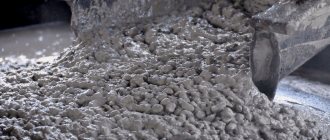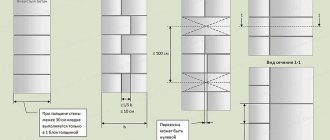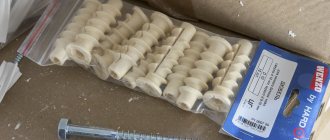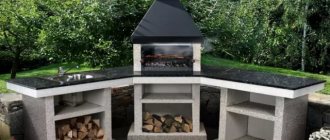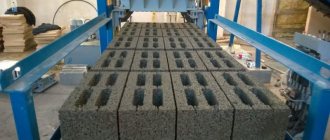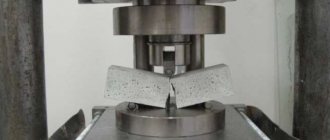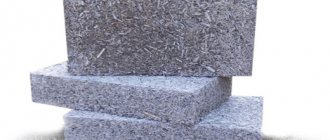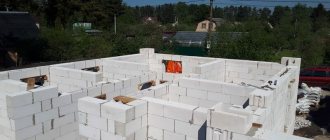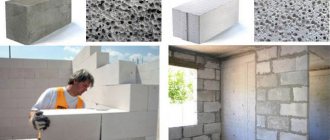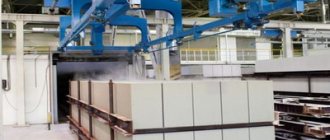Brief characteristics of aerated concrete
The technology for manufacturing aerated concrete has existed since the beginning of the last century, but it began to be actively used in construction relatively recently.
Pores in common concrete are formed by the interaction of aluminum powder and lime; during a chemical reaction, hydrogen is released, which causes the formation of cavities in the cement. These pores are evenly distributed over the entire surface of the block and give the material new properties that are not characteristic of concrete.
Consideration of these properties is very important.
Review of basic properties and qualities
The most useful property of aerated concrete is its low weight. If you compare 2 identical blocks of aerated concrete and plain concrete, the first will be several times lighter than the second. The following useful qualities are vapor permeability and low thermal conductivity.
The more pores in the block, the slower it releases heat, which means less resources will be spent on heating the building. If we compare aerated concrete with another porous material - foam concrete, it turns out that its pores are open, while those in foam concrete are closed. Therefore, the latter is inferior to aerated concrete in terms of density.
Classification and scope of application
Aerated concrete is divided into groups that depend on density. A property such as density is expressed in kg/m³.
The brand of aerated concrete determines the scope of its use:
- D300-D400. Used for thermal insulation. Blocks of this brand are called thermal insulation.
- D500-D900. It has become widespread in cottage construction. It is used for insulation of houses on the 1st floor. These blocks are called structural and thermal insulation blocks.
- D1000-D1200. Used to create walls of multi-story buildings. They are called structural.
- D600 means that 1 m³ of such concrete contains 600 kg of solid material. This will be only a third of the entire volume of the block. The rest of the volume will be air.
Advantages and disadvantages
Due to its porous structure, aerated concrete becomes more fragile compared to building materials that have a higher density. But the main disadvantage of this building material is its hygroscopicity.
In some cases, measures must be taken to minimize negative properties. For example, the blocks are waterproofed, and the moisture content of aerated concrete slabs is reduced.
Dependence of thermal conductivity on density
The thermal conductivity coefficient of aerated concrete directly depends on the density of the material. The denser its structure, the higher its ability to retain heat. In this case, there is a specific dependence of thermal insulation on the strength of the material: the less durable the aerated concrete, the better it retains heat. When choosing a brand of material, you should focus on this feature, and when building a house, choose aerated concrete of the D500-D600 brand.
The concept of thermal conductivity and its significance
The air in the cells heats up slowly and does not allow heat to escape outside. The lower the density, the lower the thermal conductivity. The concept of thermal conductivity implies the ability of a building material to transfer heat.
The greater the thermal conductivity of aerated concrete, the faster the built house will lose heat, the colder it will be at low ambient temperatures. If we compare aerated concrete brands by thermal conductivity, it turns out that blocks D300, D400 will have a lower value than D500, D600. The coefficient of different brands of aerated concrete is determined by GOST.
For example, D300 blocks will have a thermal conductivity coefficient of aerated concrete of 0.08, and D500 - 0.1. Brand D1200 will have an indicator equal to 0.29.
Density dependence
The density of a building material greatly affects its ability to conduct heat. A wall of the same thickness, but made from different materials will have different thermal conductivity.
Humidity dependent
When manufacturing blocks, deviations in thermal conductivity are allowed, but they should not be more than 20%. In addition, it should be remembered that its value indicated in the tables was obtained under good conditions without taking into account environmental influences, for example, air humidity. Thermal conductivity increases with increasing air humidity.
When building a house, the blocks will definitely come into contact with the surrounding air. Aerated concrete does not absorb water well, but this does not mean that the material is not at all susceptible to its influence. Therefore, the thermal conductivity indicators are lower than the reference ones.
The humidity of the blocks can be up to 10%. The thermal conductivity of D500 brand blocks at a high degree of humidity will increase by an average of 0.2 W/(m °C). According to experts, this is not so much.
Dependence on the quality of the macrostructure
Voids affect not only the strength level of aerated blocks. They ensure low heat loss from this material. The structural features of the product depend on the manufacturing technology. In this case, thermal conductivity depends on the size of the voids. The more voids in the material, the less heat loss. This should be taken into account when choosing a brand.
Thermal conductivity coefficient for grade D600
The average thermal conductivity coefficient for this brand of aerated concrete is 0.14 W/(m °C). In order for this material to retain heat better, it is necessary to take measures to waterproof it. But in a house after its construction, not only the blocks give off heat, but also the iron fittings. Then you need to use glue to install the blocks.
Coefficient for brand D500
The coefficient of this brand is 0.12 W/(m °C). According to this characteristic, such aerated concrete is as close as possible to the performance of brick. Therefore, it is allowed to build walls of apartment buildings from it.
Comparison of aerated concrete for heat retention with various wall materials
In order for a brick wall to have the same thermal conductivity as a 44 cm aerated concrete wall, the thickness of this wall must be several times greater, or more precisely, equal to 210 cm. Since brick has a higher density, it transfers heat more strongly.
Thermal conductivity:
- brick - 0.35 W/(m °C);
- aerated concrete grade D400 - 0.10 W/(m °C).
It turns out that a denser brick will release heat 3 times faster than aerated concrete.
According to accepted standards, the thermal conductivity of an aerated concrete wall of 44 cm corresponds to the same walls made of:
- expanded clay concrete (90 cm);
- wood (53 cm);
- mineral wool (18 cm);
- expanded polystyrene (12 cm)
When choosing between brick and gas block, the result is obvious.
Calculation of optimal wall thickness
Aerated concrete blocks are often compared to sand-lime and red bricks. And they try to bring the properties and performance of an aerated concrete wall to the characteristics of these materials. At the same time, relying on the low thermal conductivity of the walls, they make them too thin. They get the opposite result - a house with large heat losses.
Therefore, special standards have been developed to regulate the thickness of load-bearing walls made of aerated concrete. At the same time, they take into account not only the thickness, but also the degree of moisture absorption by aerated concrete. According to SNiP, when calculating the thickness of walls, such characteristics as the resistance of the structure to heat transfer are taken into account. This property depends on the region where construction is taking place and the thermal conductivity coefficient.
As for the first value, the resistance of the material, depending on the region, the difference in its values will be large, especially when comparing territories such as Moscow and Magadan.
For example, in Moscow, walls made of D500 brand gas blocks will have a thickness of 35 cm, Novosibirsk - 45 cm, Yakutsk - 65 cm.
It is necessary to adhere to the rule of the golden mean, then the optimal ratio of indicators such as strength and thermal conductivity of walls will be excellent. The D500-D600 blocks have such features. They are most often used in the construction of residential buildings and cottages, as well as other buildings.
Coefficient of thermal conductivity
Thermal conductivity coefficient is the ability of aerated concrete to transfer thermal energy. That is, the higher this coefficient, the faster the building material will release heat to the environment and make the room cold. In order not to spend money on additional heating of your home in the winter, it is worth considering in advance the choice of material for construction and methods of insulation.
A more porous structure makes aerated concrete less thermally conductive, but at the same time fragile. Different markings of aerated concrete blocks characterize their properties depending on density. Thus, the thermal conductivity of aerated concrete d300, d400 is less than the thermal conductivity of blocks marked d500, d600. Therefore, the former are most often used as thermal insulation for buildings, but due to their fragility they are not used in the construction of load-bearing structures. For the construction of residential multi-storey buildings, denser aerated concrete d1000-d1200 is suitable. The block is medium in density and insulating properties and is used in the construction of one-story buildings.
Aerated concrete blocks are divided into three types depending on density and thermal conductivity: thermal insulation (D300-500), structural-thermal insulation (D600-D900) and structural (D1000-1200).
You can compare the thermal conductivity of aerated concrete of different brands in the table:
| Marking | Thermal conductivity, W/m °C, 0% humidity | Thermal conductivity, W/m °C, 4% humidity | Thermal conductivity, W/m °C, 5% humidity |
| D300 | 0,072 | 0,084 | 0,088 |
| D400 | 0,096 | 0,113 | 0,117 |
| D500 | 0,112 | 0,141 | 0,147 |
| D600 | 0,141 | 0,160 | 0,183 |
| D700 | 0,15 | — | — |
| D800 | 0,21 | — | — |
| D900 | 0,24 | — | — |
| D1000 | 0,29 | — | — |
| D1100 | 0,34 | — | — |
| D1200 | 0,38 | — | — |
Aerated concrete blocks of the D500 brand are able to withstand the weight of walls 3 floors high along with floors. In this case, mandatory strengthening of the structure with reinforcement is provided.
Test method for thermal conductivity of products
Aerated concrete blocks are durable and convenient. But before starting construction, it is necessary to take into account all the features of the building material, including heat transfer. All these characteristics will be related to the operating conditions of the building. Therefore, the strength of the walls and their ability to conduct heat are calculated.
When conducting tests, the strength and thermal conductivity classes of aerated concrete blocks are taken into account, and only after this the wall thickness is calculated. Thermal conductivity indicators also depend on the purpose of the building.
What does the thermal conductivity of aerated concrete blocks depend on?
The thermal conductivity of aerated concrete is affected by air humidity. In a dry climate, its performance will be more favorable, but in other conditions, the ability of cellular concrete to transmit heat is almost similar to that demonstrated by brick. Each region has individual climatic and weather characteristics that require the use of certain materials. In the case of areas where there is high air humidity, they resort to using products with greater thickness, and any construction requires preliminary calculations so that the final thermal conductivity of aerated concrete does not affect the suitability of the house for use and the comfort of living in it.
Carrying out calculations involves taking into account the thickness of gas blocks, the possibility of their effective insulation and the arrangement of a potential heating system.
The thermal conductivity of aerated concrete used in the construction of walls may depend on the quality of the adhesive solution, since the places where the blocks meet are possible causes of cold penetration. The presence of armored belts also has an effect. Using ordinary concrete will cause the house to freeze very much, so builders use reinforced concrete reinforced belts to increase the thermal conductivity of aerated concrete blocks. The need to use these parts affects the financial costs of construction.
What affects the quality conductivity of heat resources?
The thermal conductivity of cellular compounds is characterized by the amount of heat that is transferred through 1 m3 of building material having a side equal to 1 m2 within 60 minutes from the outer edge to the inner one. Temperature differences between sides should not exceed 1 degree.
To understand how suitable cellular blocks are in terms of the main material for the reconstruction of a particular building or as insulation for an already erected structure, you need to familiarize yourself with information that will explain in detail the thermal conductivity capabilities of the building material and explain the main indicators and recommendations for its use.
This property of the material is greatly influenced by its porosity.
The parameters of high-quality thermal insulation of cellular concrete are regulated on the basis of the current GOST. And also the quality conductivity of heat resources depends on such parameters as:
- porosity of the building material, depending on the ingredients included in the composition;
- amount of moisture in the dry block;
- density;
- number and size of internal voids.
View "GOST 31359-2007" or
Composition of building materials
Cement stone, from which the pore walls of porous concrete are formed, is responsible for reducing the number and size of isolated air cushions inside the block. This technological feature allows you to significantly reduce possible heat transfer. The size, shape, location and type of filler also affect the thermal conductivity of the material. The fillers of the air chambers of aerated concrete or foam concrete are often the following components:
There may be ash in the air chambers of such material.
- ash from wood processing;
- natural fine-grained sands;
- lime, metallurgical slag.
Density of concrete
The mass of the formed cellular material, which is determined by volume units depending on the density, also actively affects the thermal conductivity indicators. This parameter directly depends on the type of filler used, for example, a stone whose voids are filled with ash will show completely different indicators than one on a sand base.
Cellular concrete comes in several types:
- structural;
- structural and insulating;
- thermal insulation.
The relationship between strength, density and heat-conducting blocks is shown in the table:
| Dry block density, kg/m3 | Compressive strength of the material, MPa | Elasticity of material, kN/mm2 | Thermal conductivity parameters, W/(m⋅C) | |||
| Stone on ash | Stone with sand base | On the ashes | On the sand | Ash | Sand | |
| 400 | 1,4 | 2,7 | 0,19 | 1,18 | 0,08 | 0,12 |
| 500 | 2,1 | 4,3 | 1,23 | 1,86 | 0,09 | 0,14 |
| 600 | 2,7 | 6,2 | 1,78 | 2,66 | 0,12 | 0,18 |
| 700 | 3,88 | 8,55 | 2,44 | 3,59 | 0,14 | 0,22 |
Concrete moisture content
By treating with a primer, you can prevent the material from becoming saturated with moisture.
Cellular material has the ability to absorb moisture; this factor leads to a linear increase in thermal conductivity up to 16%. If the percentage threshold is exceeded within a reasonable range, the indicator will not create a significant impact on heat transfer. The stability of heat conservation occurs due to the ability of moisture accumulated inside the block to retain thermal resources. To protect walls from the harmful effects of excessive liquids, a vapor-proof primer must be used. A suitable moisture threshold for the operation of a rebuilt building is acquired 3-4 years after completion of construction. The adaptation humidity of cellular concrete should not exceed 30-37%.
